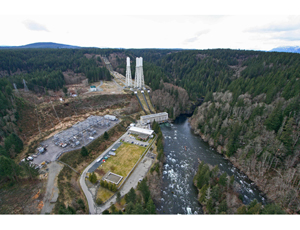
Despite recent criticism of exorbitant rate increases tied to its building program, Canadian provincial utility company BC Hydro awarded a $900-million contract to the design-build team of Montreal-based SNC-Lavalin and Argentina-based IMPSA to replace the 65-year-old John Hart Generating Station on Vancouver Island.
The project involves the construction of a replacement water intake at the John Hart Spillway Dam, replacement of the three penstocks with an approximately 1.2-mile-long tunnel, construction of a new generating station beside the existing station and a new water bypass facility.
The utility says the new facilities wlll boost power reliability, reduce environmental impact on fish habitats and be able to withstand a low to moderate earthquake.
The SNC-IMPSA team bested two other international consortia, says Maxim Sytchev, engineering and construction sector analyst for Dundee Capital Markets, Toronto.
The unsuccessful bidders included, on one joint venture, Paris-based Bouygues, Knight Piesold Consulting and ALSTOM Power & Transport Canada Inc.; the other JV included Germany's Bilfinger Berger, Spain's Acciona, Barnard Construction, Klohn Crippen Berger, Voith Hydro and Siemens.
Eight teams submitted initial proposals.
If the final contract is signed in January as anticipated, SNC-Lavalin will be asked to front 60% of the cost and would get paid back over time, based on performance. The price tag includes project financing, BC Hydro said.
BC Hydro’s power consumers have been growing agitated with high rates, however, according to a published report in Vancouver. It claims the utility had plans to increase electricity rates by up to 24.6% by 2016.
“There certainly has been criticism in [British Columbia] and elsewhere that public-private partnerships allow the utility to pass debt off to the consortium,” says Keith Sashaw, president of the Association of Consulting Engineering Companies in British Columbia.
“But I am an advocate of public-private partnerships because I think they are an effective management of public funds. The public does get benefits of service from the construction and maintenance contract and does get the asset,” Sashaw added.
Because 60% of payments for the project are deferred over 15 years, interest rates and a low-cost, efficient design were high priorities for BC Hydro in awarding the project. “SNC-Lavalin came in with a low bid and design that replaces three pipelines with one tunnel, [which] gives BC Hydro what it wanted,” says Steven Watson, spokesman for BC Hydro.
SNC-Lavalin’s partnership with “world class" turbine builder IMPSA was also a selling point, Watson says.
“The units are a much more reliable source of generation for consumers, but, even in the event that one is inoperable, the design allows operators to bypass it and switch flows and keep the downstream flows maintained at a good velocity," he notes.
Downstream flows are critical to sustain a renowned fish habitat and the surrounding ecosystem of the lower Campbell River, Watson explains.
Repayments, scheduled for a 15-year period, hinge on performance clauses in the contract, which were developed by BC Hydro's independent consultants.
“P3s allow the owner to bring in all the players at a very early stage—designer, contractor, financiers—so all the parties are very aware of those performance clauses,” Sashaw says. “There are no surprises.”
BC Hydro says the project will create 400 construction jobs per year, on average, over its five years of construction.
The Hart powerplant is one of BC Hydro's oldest generating faciities.
SNC-Lavalin announced earlier this month a $70-million loss for its third quarter as well as a slight decline in revenue, to $1.95 billion from $1.98 billion, for the same quarter a year earlier. The firm, which attributed the results to money-losing contracts and a restructuring in Europe, had earlier warned of the lower earnings.
Assuming a 50-50 split between SNC-Lavalin and IMPSA, Sytchev said the contract would represent 23% of backlog in the Canadian firm's power-division backlog, as of its third quarter.
"We are still in the early innings of a re-rating process," he said in a Nov. 19 research note. "We reiterate our belief that its [E&C] business, despite its well-documented issues, is not imploding, as some have assumed."

Post a comment to this article
Report Abusive Comment